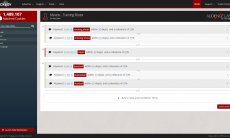Recently, my study and practice of Content Marketing has caused me to reexamine my years in automobile retail marketing and OEM branding offline. While I maintain some contact with the dealer world I once called home, I’ve come to realize how far our industry has come. At the same time, I see how the dealers’ time and resources have limited their exposure to and understanding of the opportunities being missed. As the first part of a deeper dive into this multi-billion dollar industry, I’d like to begin by laying out the current state of dealers in a digital marketplace and open the discussion on those as of yet unrealized opportunities. In later posts, I’ll address new things I’ve learned from other industries who are farther down the road, because, like many industries, automotive tends to be insular and non-receptive or unfamiliar with the lessons learned elsewhere. Hopefully whatever kind of marketing the readers of this post may be engaged in, there are common takeaways that can help them understand the consumer better.
In the case of automotive, the industry’s marketing support has limited innovation at least in part due to self-interest, stagnant relationships, and complacency. On a retail level, car and truck dealers characteristically cling to their current business models. However, they would do well to master the challenges of a rapidly changing digital landscape while expending energy, and redirect some resources to stay current with trends. The following are some benefits and where the industry can innovate and differentiate through throughout their business model.
Below are a few key trends that work in dealer’s favor that I expect will give them an enormous opportunity in re-imagining the automotive retail landscape, since I’ve observed it is slow to change.
Compared to a decade ago, customers today are experiencing new sales processes in many industries and categories, such as unique shopping experiences in branded electronics stores, online retail with advanced customer relationship management, intelligent product suggestions, or seamless integration of online and offline business. Automotive OEMs (original equipment manufacturers) and dealer networks (dealer groups and associations) are aware of these trends, but remain largely paralyzed because of a lack of consensus or having few options when seeking help in redirecting resources.
Car buyers nowadays design their decision and experience journey individually from many different touch points. Recent surveys have shown that over 80 percent of new-car and almost 100 percent of used-car customers now begin their journey online, meaning that dealers have lost their role as the primary source of basic product information, as well as their power over the information shared and its ability to influence the customer. As might be expected, the role of online sources is even more pronounced among customers between the ages of 18 and 34. The impressions and relationships these customers experience can last a lifetime.
Close to 90 percent of these customers use an extensive variety of online sources – OEM and dealer Web sites, social media, blogs, and forums – to gather information and compare offers, moving the purchasing decision further towards the online world. The rise of mobile technologies, tablets, and social media is also redefining interaction and communication patterns, while technological innovations, such as mobile apps, multimedia walls, and OEM 3D configurators are attempting to bring new opportunities to transform the in-store experience, but with tepid dealer interest.
Consequently, the number of customer visits to a dealer before the purchasing decision is made has tumbled. Dealers often get just one chance to close a transaction, thus raising the stakes and changing their behavior. More attention needs to be paid to experiential visits, website design, and integrating traffic from third-party web sites, such as Kelley Blue Book, Consumer Reports, or JD Power. Yet showroom visits in most markets yield only a 30-40% closing rate where customers actually buy then. Many customers often return to online research after a visit and these third-party web sites, finding them more useful for comparing different models side by side. Customers are increasingly well informed and thus more demanding, while dealers are not yet sufficiently prepared and have few skilled marketing partners to look to for improvement with the new challenges ahead.
Deep technical understanding of the car beyond surface website content will be a requirement for any sales person, and is even more important as new technologies enter the market. Vehicles with electric powertrains, for example, or more advanced infotainment and active safety technologies can’t be adequately covered in a dealer website. In short, customers expect dealers to know about their product than just the latest model names and brochure features. But they can’t stop there!
The second and often misunderstood opportunity for the digitally astute dealer is that traditional car dealerships will remain crucial in the customer decision journey in satisfying a customers’ need for trustworthy, expert advice. As customers increasingly collect general information online, dealers are ever more being viewed as an advanced “second-level support” for questions and doubts that neither the online configurators nor the OEM Web sites had foreseen. Market research shows that the need for further consultation after an online search, even a showroom visit, is higher for cars than for most any other consumer product. On top of this, advice on additional services around a car purchase will become increasingly important in differentiating dealer offerings that support the dealer’s brand.
Finally, dealerships will also remain crucial in the customer decision journey as the personal trust between sales staff and the customer plays a central role, especially in the case of conflicting information or tight trade-off decisions between brands and vehicle models. This is where trust and confidence come into play as I covered in my piece on Full Funnel Marketing last month. After the sale, OEMs will continue to require a strong dealer network to serve as their local brand ambassadors and provide customers with high-quality vehicle maintenance and service in a convenient location. The dealer often overlooks this too as an opportunity to support its own brand. So every return shopping visit and every service visit is another chance to get it right and star building a relationship.
This is particularly true for used-car shopping and sales because they cannot be sold as commodities the way new ones are. The fact still remains that it is hard to describe the exact state of a used car in text and pictures with potential buyers wanting to physically examine the car before making a purchasing decision. Another example of this desire for physical experience is the touch, feel, hear in person test-drive, which is traditionally one of the most critical dealer-related moments of truth. It is an extraordinary opportunity to communicate differentiation. In some ways, the importance of traditional dealerships has diminished, but the bricks-and-mortar car dealerships will remain a crucial customer touch point if properly leveraged.
To recap, most customers will always want to physically experience the vehicle before purchase as it is typically one of their largest investments. But those who gamble everything into that moment without any prior research other than product info online are making a fatal mistake. Customers also frequently seek expert advice on optional equipment and support services (such as insurance and financing options) as well as detailed information that is either not available or not adequately answered online. The current industry culture based on sharing “just enough” information needs to be more comprehensive and genuine.
Now, ready for the 600 pound Gorilla in the room? The reasons I’ve cited on why dealers will survive, and the ways I have touched on where they have to change overlook one of the most powerful buying incentives in any industry. While most dealers monitor and participate third party review sites like Dealer Rater or Yahoo, the person to person, word of mouth referral by a friend or relative via social media, or in a personal conversation, of a product and dealer has been largely overlooked. This is by far the most powerful incentive in their marketing toolbox. Once again, dealers who built their business on word of mouth now see cultivating it digitally as cumbersome and difficult to justify on an ROI basis. Yet, ironically, there are more tools, platforms, and other industry experiences that can make it a reality right now. This is a skill set that is easily acquired and cost effective in maintaining.
Despite what common industry clichés have perpetuated, OEMs will continue to be alienated from buyer relationships and customers will continue to value the personal aspect of the dealership sales process, which forms the basis of brand representation, customer retention, and service offerings. The dealer that grasps the opportunity to improve the experience needs to start long before the actual showroom visit. Those who succeeds at leveraging the power of Customer Experience and Advocacy will turn this industry on its ear.





